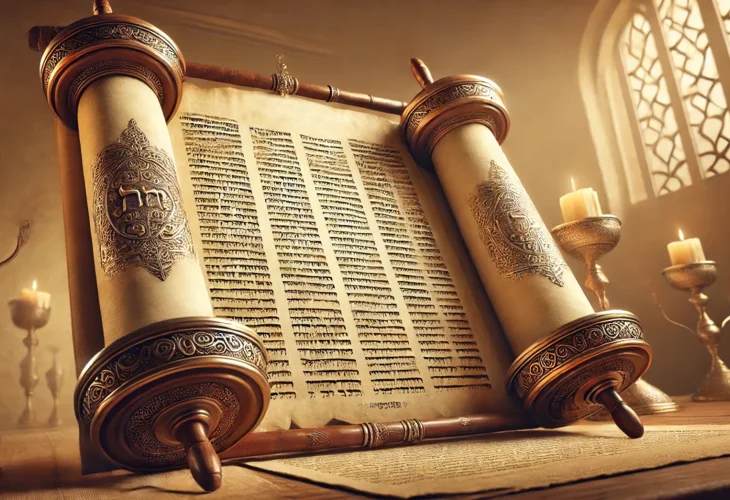Unveiling the Mysteries of Biblical Punctuation: Surprising Discoveries
Our ancestors dedicated their lives to preserving every letter and punctuation in the Scriptures, and indeed, their precision delivers the stories exactly as they were meant to be told.
- יהוסף יעבץ
- פורסם י"ג חשון התשפ"ה

#VALUE!
The vowel markings in the Torah and the Prophets were passed down orally over many centuries. For instance, when the Torah states "v'tim'ah shiv'im," it could be read as seventy – 70, or sh'vuayim – 14 days. Tradition dictates that the correct reading is two weeks.
Often, the punctuation in tradition surprises us. For example, in Ezekiel 27, we read "v'nis'u b'nayhem kinnah." Any scribe would punctuate it as b'nayhem, in the usual form, but the tradition punctuates it as b'nihem, indicating lamentation and mourning, with 'b' as the usage letter.
In the Book of Job (40:30), it is written: "yacharu alav chavirim," meaning that one might expect the punctuation to be "chaveirim," but in tradition, it is punctuated "chabbarim." Today, we know that in ancient times merchants were called "chabbarim," and this term appears in an Egyptian letter from the 11th century BCE, which aligns with Job's continuation, mentioning Canaanites.
And here's a fascinating historical insight hidden in a single note passed down orally for centuries: Who captured Samaria? In 2 Kings (18:10), it is written: "And it came to pass in the fourth year of King Hezekiah, Shalmaneser king of Assyria came up against Samaria, and besieged it and took it at the end of three years." Without punctuation, one would read it as "vayilch'dah" - Shalmaneser captured it, but tradition punctuates "vayilch'du'ah." Assyrian engravings revealed that Shalmaneser died in the second year of the siege of Samaria, and his general Sargon was the one to conquer Samaria. Thus "vayilch'du'ah" — they, the Assyrians, without their king Shalmaneser.
The precision of tradition became clear after Assyrian inscriptions with the names of ancient kings were discovered. While Greek scribes distorted the names, which is naturally expected, the biblical texts preserved them accurately. The king "Evil-Merodach" is called "Iloroadomus" in Greek, Nebuchadnezzar is "Nabokolasaros," Sargon is "Arcianus," and so forth.
In the ruins of Persepolis in Persia, inscriptions were found that researchers couldn't decipher for a long time. The central name in the inscription was unfamiliar to European researchers, as they relied on the distorted names in Greek history. Until a researcher named Friedrich Grotefend decided to consult the Bible for the names of the Persian kings and found the exact name "Darius," enabling him to understand what was written in the inscription.
In Jeremiah (39:3), it says: "And all the princes of the king of Babylon came and sat in the middle gate: Nergal-sharezer, Samgar-nebo, Sarsechim, Rabsaris, Nergal-sharezer, Rabmag, and all the rest of the princes of the king of Babylon." The list of ministers consists of 12 words, but how many people are counted here? The names Nergal and Sharezer appear twice! Yet the cantillation marks reveal the correct division, according to the marks: "Nergal-sharezer Samgar-nebo" is one name, and "Sarsechim Rabsaris" is the second, "Nergal-sharezer Rabmag" – the third. Altogether, three ministers... These names are well-known from Babylonian cuneiform writings. The cuneiform texts tell us that the first was Nebuchadnezzar's son-in-law, and his name means: protector of the prince. The addition of Samgar-nebo means noble of kindness, probably to distinguish him from his counterpart Nergal-sharezer Rabmag. Rabmag means chief magician.
In Ezekiel (38:2), it says: "Set your face against Gog, the land of Magog, the chief prince of Meshech and Tubal" (three times, with equal punctuation and cantillation marks), the reader might understand that "chief prince" is a title of honor, and that Gog is the prince over Meshech and Tubal. But the cantillation marks (a major pause on the word "chief") set apart the word "chief" as an introduction to the whole expression. Indeed, the leaders of Meshech and Tubal are "Tubal, Meshech, and Tiras" (Genesis 10:2). Tiras correspond to Russians, according to some sources. Hence, Gog is the leader of "Rosh, Meshech, and Tubal."
Our ancestors dedicated their lives to preserving every letter and punctuation in the Scriptures, and indeed, their precision delivers the stories exactly as they were meant to be told.

